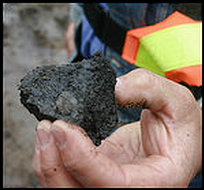Untitled Document
 |
|
The tar-like oil sands are mined and processed to make synthetic oil. (By Doug Struck -- The Washington Post)
|
Huge Mines Rapidly Draining Rivers, Cutting Into Forests, Boosting
Emissions
FORT MCMURRAY, Alberta -- Huge mines here turning tarry sand into cash for
Canada and oil for the United States are taking an unexpectedly high environmental
toll, sucking water from rivers and natural gas from wells and producing large
amounts of gases linked to global warming.
The digging -- into an area the size of Maryland and Virginia combined -- has
proliferated at gold-rush speed, spurred by high oil prices, new technology
and an unquenched U.S. thirst for the fuel. The expansion has presented ecological
problems that experts thought they would have decades to resolve.
"The river used to be blue. Now it's brown. Nobody can fish or drink from
it. The air is bad. This has all happened so fast," said Elsie Fabian,
63, an elder in a native Indian community along the Athabasca River, a wide,
meandering waterway once plied by fur traders. "It's terrible. We're surrounded
by the mines."
From her home on the bluff of the river, she can see billowing steam rising
from a vast strip mine 10 miles away. There, almost 200 feet below what was
once a forest, giant machines cleave the earth into a cratered moonscape. Immense
shovels plunge into the ground, wresting out massive chunks. Trucks the size
of houses prowl the pit. They deliver the black soil to clanking conveyers and
vats that steam the tar from the sand.
The miners have created a marvel of human industry that takes a spongy muck
once considered worthless and converts it into oil for gasoline, diesel and
jet fuel. But the price of that alchemy is high: Each barrel of oil requires
two to five barrels of water, carves up four tons of earth, uses enough natural
gas to heat a home for one to five days, and adds to the greenhouse gases slowly
cooking the planet, according to the industry's own calculations.
"The environmental cost has been great," said Jim Boucher, chief
of the Fort MacKay First Nations Council, which includes Cree and Dene Indians,
35 miles north of Fort McMurray. He grew up on land that is now a clawed-out
mine pit. But he has led his people into the mines by creating native-owned
companies providing catering, truck driving, surveying and other services. "There
is no other economic option," he said. "Hunting, trapping, fishing
is gone."
Operators of the mines, which have helped make Canada the largest supplier
of oil to the United States, believe they can find technological solutions to
the environmental problems.
"There is a whole lot of work being done," Charles Ruigrok, chief
executive of Syncrude, one of the largest companies, said at his corporate headquarters
in downtown Fort McMurray. "I do believe technology will fix it."
The oil companies point to steady reductions in the amount of water and natural
gas used to produce each barrel of oil, for example. But those efficiency gains
have been wiped out by the rise in the number of barrels produced. Increasingly,
environmental organizations are calling for a moratorium on the growth of the
mines.
"We shouldn't be issuing new permits. We are foreclosing our future,"
said Dan Woynillowicz, who headed an extensive study for the Pembina Institute,
an Alberta-based nonprofit that conducts research on environmental issues. "In
the 1990s, we acknowledged environmental challenges would occur. But we are
17 years ahead of schedule."
When the oil sands became recognized as economically viable in 2003, Canada
suddenly emerged as holder of the world's second-largest oil reserves, behind
Saudi Arabia. By 2015, according to industry forecasts, the oil sands will account
for at least one-fourth of North America's oil production.
The United States already is counting on Canada to help wean it from oil from
the Middle East. Other countries are eyeing the wealth; China has invested in
two mining companies and a pipeline to move oil from Alberta to shipping ports
on the Pacific.

